College Introduction Letter
[Your Name]
[Your Address]
[City, State, ZIP Code]
[Email Address]
[Phone Number]
[Date]
[Admission Committee/Office]
[College/University Name]
[College Address]
[City, State, ZIP Code]
Dear [Admission Committee/Office],
I am writing to express my sincere interest in becoming a part of the [College/University Name] community and to introduce myself as an enthusiastic and motivated prospective student. As I embark on this exciting journey of pursuing higher education, I am thrilled at the prospect of contributing to and benefiting from the academic excellence and vibrant campus life that [College/University Name] is renowned for.
Allow me to share a little about myself. I am a [High School Graduation Year] graduate from [High School Name], where I have consistently demonstrated a strong dedication to my studies and extracurricular activities. Throughout my high school years, I have actively engaged in various leadership roles, such as [Leadership Position] of [Club/Organization Name], which has honed my organizational and teamwork skills. These experiences have instilled in me a sense of responsibility and a drive to make a positive impact within a diverse and dynamic academic environment.
My passion for [Your Field of Interest/Major] was ignited during [Relevant Experience/Event], and I am eager to further explore this subject in-depth at [College/University Name]. The reputation of your esteemed institution's faculty, cutting-edge research opportunities, and robust curriculum align seamlessly with my academic aspirations and commitment to excellence. I am excited about the prospect of engaging in thought-provoking discussions, collaborative projects, and hands-on experiences that will contribute to my personal and intellectual growth.
Moreover, beyond academics, I am drawn to [College/University Name] due to its vibrant campus culture and diverse student body. I am excited about the prospect of participating in [Extracurricular Activity/Club], engaging in community service initiatives, and forging meaningful connections with fellow students who share my interests and values.
I am particularly impressed by [Specific Program/Facility] at [College/University Name], which aligns perfectly with my goals and offers opportunities for practical application of my knowledge. I am eager to leverage these resources to not only enhance my academic journey but also contribute positively to the [College/University Name] community.
I would like to express my gratitude for considering my application and the opportunity to be part of [College/University Name]. Enclosed, please find my completed application forms and the required documents. I eagerly await the chance to contribute to the academic excellence and vibrant campus life that [College/University Name] offers.
Thank you for your time and consideration. I look forward to the possibility of joining [College/University Name] and eagerly anticipate the opportunity to learn, grow, and thrive within its esteemed academic environment.
Sincerely,
[Your Signature]
[Your Printed Name]
Enclosure: [List of Enclosed Documents, e.g., Application Forms, Transcripts, Letters of Recommendation]
Formal College Introduction Letter
Subject: Introduction to [Your Name]
Dear [Recipient Name],
I am writing to introduce myself as a new student at [College Name] for the [Program Name]. My name is [Your Name], and I recently enrolled to pursue [specific course or field].
I am eager to engage with faculty, participate in college activities, and contribute positively to the community. Please feel free to reach out to me for any guidance or collaboration opportunities.
Thank you for your attention.
Sincerely,
[Your Name]
[Contact Information]
Casual Student Introduction Email
Hi [Professor/Coordinator Name],
My name is [Your Name], and I’ve just joined [College Name] in the [Program Name]. I’m excited to be part of this community and look forward to meeting everyone and learning as much as possible.
Please let me know if there are any upcoming events or orientations I should attend.
Best regards,
[Your Name]
Heartfelt College Introduction Letter
Dear [Recipient Name],
I am thrilled to introduce myself as a new member of [College Name]. My name is [Your Name], and I have a deep passion for [subject or field]. Joining this institution represents a dream come true for me, and I am eager to contribute to the college’s academic and social environment.
I hope to connect with faculty and fellow students to build meaningful relationships and enhance my learning journey.
Warm regards,
[Your Name]
Quick / Simple Introduction Email
Hello [Recipient Name],
My name is [Your Name], and I’ve recently enrolled in [Program Name] at [College Name]. Looking forward to connecting with the faculty and peers.
Thank you,
[Your Name]
Introduction Letter for Internship Placement
Subject: Introduction of Student [Your Name]
Dear [Coordinator/Company Name],
I am [Your Name], a student at [College Name] enrolled in [Program Name]. I am reaching out to introduce myself as I will be participating in an internship placement under your guidance.
I am eager to learn, contribute, and apply my academic knowledge to practical experiences. Please let me know if there are any preparatory materials or procedures I should follow.
Sincerely,
[Your Name]
[Contact Information]
Provisional / Preliminary Introduction Letter
Dear [Recipient Name],
This letter serves as a preliminary introduction of myself as a prospective student at [College Name]. My name is [Your Name], and I am interested in joining [Program Name] for the upcoming semester.
I look forward to further instructions regarding orientation, registration, and college formalities.
Best regards,
[Your Name]
Introduction Letter for Student Exchange Program
Subject: Introduction of Student [Your Name]
Dear [Exchange Program Coordinator],
I am [Your Name], currently enrolled at [Home College Name] in [Program Name]. I am excited to participate in the exchange program at [Host College Name] and eager to contribute to both academic and cultural exchanges.
I hope to establish connections with faculty and peers, and I am ready to comply with all program requirements.
Sincerely,
[Your Name]
[Contact Information]
What / Why do you need a College Introduction Letter
A college introduction letter is a formal or informal communication intended to introduce a new student to the college, faculty, or peers.
The purposes include:
- Facilitating initial connections with faculty, staff, or student groups.
- Providing context about the student’s background, program, or interests.
- Serving as a professional or personal introduction for opportunities like internships or exchange programs.
- Establishing a positive first impression within the academic community.
Who should send a College Introduction Letter
- New students joining a college or university.
- Students participating in specific programs like internships, exchanges, or research projects.
- Student representatives or club leaders introducing themselves to faculty or new groups.
- Sometimes, faculty or advisors may send on behalf of students in official capacities.
Whom should the College Introduction Letter be addressed to
- College administration or program coordinators for official introduction.
- Professors or faculty members responsible for the student’s academic program.
- Student organizations or clubs for social integration.
- Internship hosts or exchange program coordinators when relevant.
When to write and send a College Introduction Letter
- Upon enrollment or admission to the college.
- Before starting classes or attending orientation sessions.
- Prior to beginning internships, exchange programs, or special academic projects.
- When joining student groups or societies for the first time.
How to write and send a College Introduction Letter
- Begin with a formal or friendly greeting depending on the recipient.
- Introduce yourself clearly: name, program, year of study, and relevant background.
- Mention your purpose for writing, such as joining the college, participating in a program, or networking.
- Include any relevant experiences, achievements, or interests.
- Close with a positive note and provide contact information.
- Send via email for casual or immediate communication, or as a printed letter for official formal introductions.
How many College Introduction Letters should be written
- One letter per distinct recipient or group is recommended.
- Additional letters may be necessary for internship hosts, exchange programs, or special projects.
- Avoid multiple repetitive letters to the same recipient unless updating information.
FAQ about College Introduction Letters
- Q: Should I include personal hobbies in the letter?
A: Only if relevant to the program or to connect socially with peers. - Q: Is it necessary to use a formal tone?
A: Depends on the recipient; professional tone for faculty, casual for peers. - Q: Can this letter be emailed?
A: Yes, email is acceptable and often preferred for quick communication.
Requirements and Prerequisites
- Confirmed admission or enrollment in the college.
- Knowledge of your program, interests, and academic background.
- Awareness of recipient type and appropriate tone (formal, casual, or friendly).
- Contact information for follow-up or queries.
Formatting and Style Guidelines
- Length: One page or one email screen.
- Tone: Professional for faculty; friendly or casual for peers.
- Style: Clear, concise paragraphs with logical flow.
- Mode: Printed letter for formal occasions, email for digital introduction.
- Etiquette: Polite language, no excessive personal details, positive tone.
After Sending / Follow-up
- Ensure acknowledgment from recipient if required.
- Participate in any scheduled meetings or orientations.
- Use the introduction letter as a conversation starter in networking or academic discussions.
- Update recipients with any changes in program status or contact details if relevant.
Pros and Cons of Sending a College Introduction Letter
Pros:
- Creates a professional or personal first impression.
- Facilitates connections with faculty, peers, or program coordinators.
- Provides clarity about the student’s background and goals.
Cons: - Time-consuming if writing multiple letters.
- May seem unnecessary if the college provides formal orientation introductions.
- Risk of errors in tone or content if not carefully drafted.
Compare and Contrast with Other Types of Letters
- Welcome Letter from College: Initiated by the institution; less personal for the student.
- Email Introduction to Peers: Quick and informal; suitable for social integration.
- Formal Program Introduction: Required for internships or exchange programs; more detailed and structured.
- College introduction letters combine personal background with formal clarity for specific academic contexts.
Tricks and Tips
- Personalize each letter according to recipient and purpose.
- Highlight key academic or professional achievements.
- Keep it concise but informative.
- Use a friendly tone when appropriate, but remain polite and professional.
- Include contact information and readiness to engage further.
Common Mistakes
- Writing overly long or unfocused letters.
- Using informal language with formal recipients.
- Omitting essential details like program name or year of study.
- Failing to proofread for grammar or clarity.
- Sending to wrong recipient or multiple unnecessary copies.
Elements and Structure of a College Introduction Letter
- Subject Line: Clearly states purpose of the letter.
- Greeting: Tailored to the recipient (formal or casual).
- Introduction: Student’s name, program, and year of study.
- Purpose Statement: Reason for writing (joining, internship, exchange).
- Relevant Background: Academic, professional, or personal achievements.
- Closing Statement: Express interest in engagement and positive outlook.
- Contact Information: Email, phone number, or other preferred communication.
- Signature: For printed letters or formal digital letters.
Does it require attestation or authorization
- Typically, no external attestation is needed for standard student introductions.
- Official programs, exchanges, or internships may require verification from college authorities or advisors.
- Always confirm requirements if the introduction is for formal or external purposes.
Formal College Introduction Letter
Subject: Introduction to [Your Name]
Dear [Recipient Name],
I am writing to introduce myself as a new student at [College Name] for the [Program Name]. My name is [Your Name], and I recently enrolled to pursue [specific course or field].
I am eager to engage with faculty, participate in college activities, and contribute positively to the community. Please feel free to reach out to me for any guidance or collaboration opportunities.
Thank you for your attention.
Sincerely,
[Your Name]
[Contact Information]
Casual Student Introduction Email
Hi [Professor/Coordinator Name],
My name is [Your Name], and I’ve just joined [College Name] in the [Program Name]. I’m excited to be part of this community and look forward to meeting everyone and learning as much as possible.
Please let me know if there are any upcoming events or orientations I should attend.
Best regards,
[Your Name]
Heartfelt College Introduction Letter
Dear [Recipient Name],
I am thrilled to introduce myself as a new member of [College Name]. My name is [Your Name], and I have a deep passion for [subject or field]. Joining this institution represents a dream come true for me, and I am eager to contribute to the college’s academic and social environment.
I hope to connect with faculty and fellow students to build meaningful relationships and enhance my learning journey.
Warm regards,
[Your Name]
Quick / Simple Introduction Email
Hello [Recipient Name],
My name is [Your Name], and I’ve recently enrolled in [Program Name] at [College Name]. Looking forward to connecting with the faculty and peers.
Thank you,
[Your Name]
Introduction Letter for Internship Placement
Subject: Introduction of Student [Your Name]
Dear [Coordinator/Company Name],
I am [Your Name], a student at [College Name] enrolled in [Program Name]. I am reaching out to introduce myself as I will be participating in an internship placement under your guidance.
I am eager to learn, contribute, and apply my academic knowledge to practical experiences. Please let me know if there are any preparatory materials or procedures I should follow.
Sincerely,
[Your Name]
[Contact Information]
Provisional / Preliminary Introduction Letter
Dear [Recipient Name],
This letter serves as a preliminary introduction of myself as a prospective student at [College Name]. My name is [Your Name], and I am interested in joining [Program Name] for the upcoming semester.
I look forward to further instructions regarding orientation, registration, and college formalities.
Best regards,
[Your Name]
Introduction Letter for Student Exchange Program
Subject: Introduction of Student [Your Name]
Dear [Exchange Program Coordinator],
I am [Your Name], currently enrolled at [Home College Name] in [Program Name]. I am excited to participate in the exchange program at [Host College Name] and eager to contribute to both academic and cultural exchanges.
I hope to establish connections with faculty and peers, and I am ready to comply with all program requirements.
Sincerely,
[Your Name]
[Contact Information]
What / Why do you need a College Introduction Letter
A college introduction letter is a formal or informal communication intended to introduce a new student to the college, faculty, or peers.
The purposes include:
- Facilitating initial connections with faculty, staff, or student groups.
- Providing context about the student’s background, program, or interests.
- Serving as a professional or personal introduction for opportunities like internships or exchange programs.
- Establishing a positive first impression within the academic community.
Who should send a College Introduction Letter
- New students joining a college or university.
- Students participating in specific programs like internships, exchanges, or research projects.
- Student representatives or club leaders introducing themselves to faculty or new groups.
- Sometimes, faculty or advisors may send on behalf of students in official capacities.
Whom should the College Introduction Letter be addressed to
- College administration or program coordinators for official introduction.
- Professors or faculty members responsible for the student’s academic program.
- Student organizations or clubs for social integration.
- Internship hosts or exchange program coordinators when relevant.
When to write and send a College Introduction Letter
- Upon enrollment or admission to the college.
- Before starting classes or attending orientation sessions.
- Prior to beginning internships, exchange programs, or special academic projects.
- When joining student groups or societies for the first time.
How to write and send a College Introduction Letter
- Begin with a formal or friendly greeting depending on the recipient.
- Introduce yourself clearly: name, program, year of study, and relevant background.
- Mention your purpose for writing, such as joining the college, participating in a program, or networking.
- Include any relevant experiences, achievements, or interests.
- Close with a positive note and provide contact information.
- Send via email for casual or immediate communication, or as a printed letter for official formal introductions.
How many College Introduction Letters should be written
- One letter per distinct recipient or group is recommended.
- Additional letters may be necessary for internship hosts, exchange programs, or special projects.
- Avoid multiple repetitive letters to the same recipient unless updating information.
FAQ about College Introduction Letters
- Q: Should I include personal hobbies in the letter?
A: Only if relevant to the program or to connect socially with peers. - Q: Is it necessary to use a formal tone?
A: Depends on the recipient; professional tone for faculty, casual for peers. - Q: Can this letter be emailed?
A: Yes, email is acceptable and often preferred for quick communication.
Requirements and Prerequisites
- Confirmed admission or enrollment in the college.
- Knowledge of your program, interests, and academic background.
- Awareness of recipient type and appropriate tone (formal, casual, or friendly).
- Contact information for follow-up or queries.
Formatting and Style Guidelines
- Length: One page or one email screen.
- Tone: Professional for faculty; friendly or casual for peers.
- Style: Clear, concise paragraphs with logical flow.
- Mode: Printed letter for formal occasions, email for digital introduction.
- Etiquette: Polite language, no excessive personal details, positive tone.
After Sending / Follow-up
- Ensure acknowledgment from recipient if required.
- Participate in any scheduled meetings or orientations.
- Use the introduction letter as a conversation starter in networking or academic discussions.
- Update recipients with any changes in program status or contact details if relevant.
Pros and Cons of Sending a College Introduction Letter
Pros:
- Creates a professional or personal first impression.
- Facilitates connections with faculty, peers, or program coordinators.
- Provides clarity about the student’s background and goals.
Cons: - Time-consuming if writing multiple letters.
- May seem unnecessary if the college provides formal orientation introductions.
- Risk of errors in tone or content if not carefully drafted.
Compare and Contrast with Other Types of Letters
- Welcome Letter from College: Initiated by the institution; less personal for the student.
- Email Introduction to Peers: Quick and informal; suitable for social integration.
- Formal Program Introduction: Required for internships or exchange programs; more detailed and structured.
- College introduction letters combine personal background with formal clarity for specific academic contexts.
Tricks and Tips
- Personalize each letter according to recipient and purpose.
- Highlight key academic or professional achievements.
- Keep it concise but informative.
- Use a friendly tone when appropriate, but remain polite and professional.
- Include contact information and readiness to engage further.
Common Mistakes
- Writing overly long or unfocused letters.
- Using informal language with formal recipients.
- Omitting essential details like program name or year of study.
- Failing to proofread for grammar or clarity.
- Sending to wrong recipient or multiple unnecessary copies.
Elements and Structure of a College Introduction Letter
- Subject Line: Clearly states purpose of the letter.
- Greeting: Tailored to the recipient (formal or casual).
- Introduction: Student’s name, program, and year of study.
- Purpose Statement: Reason for writing (joining, internship, exchange).
- Relevant Background: Academic, professional, or personal achievements.
- Closing Statement: Express interest in engagement and positive outlook.
- Contact Information: Email, phone number, or other preferred communication.
- Signature: For printed letters or formal digital letters.
Does it require attestation or authorization
- Typically, no external attestation is needed for standard student introductions.
- Official programs, exchanges, or internships may require verification from college authorities or advisors.
- Always confirm requirements if the introduction is for formal or external purposes.

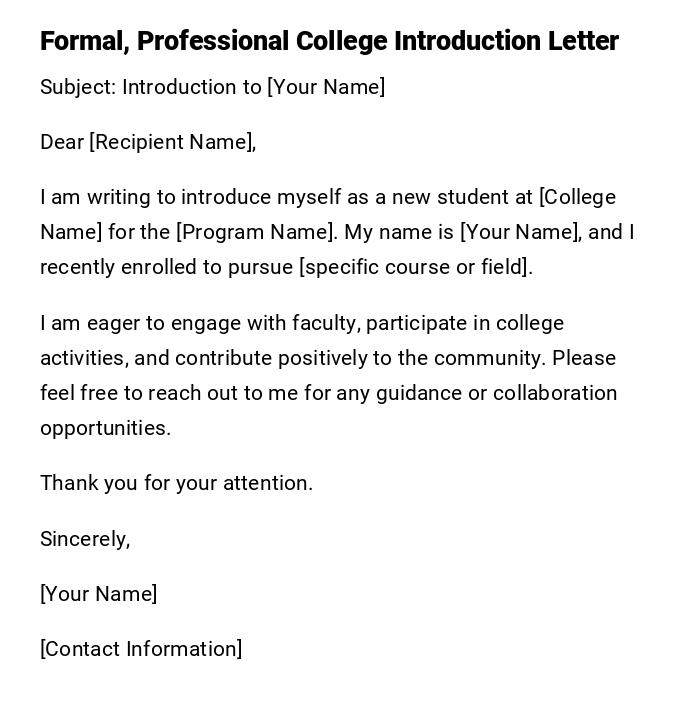
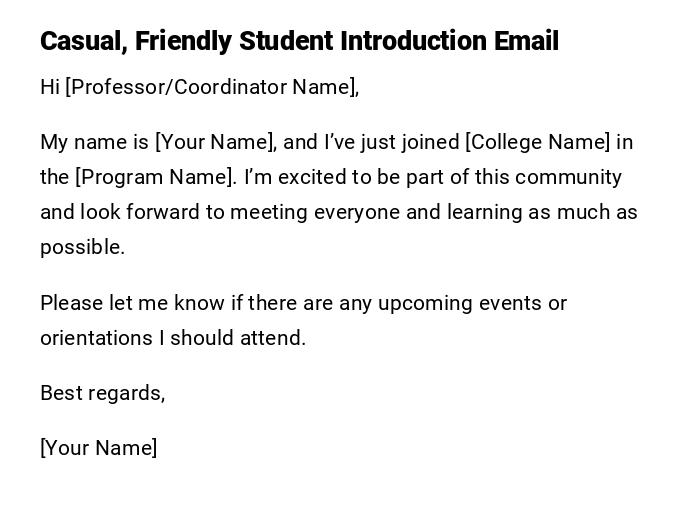
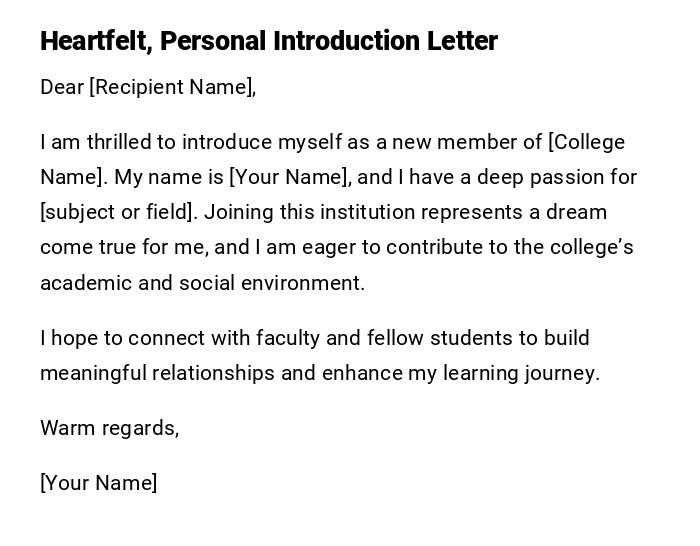
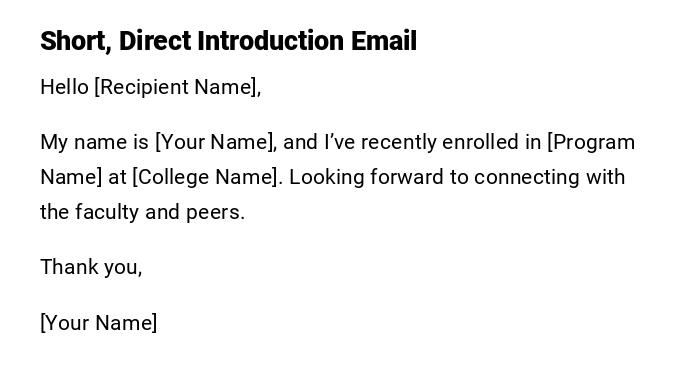
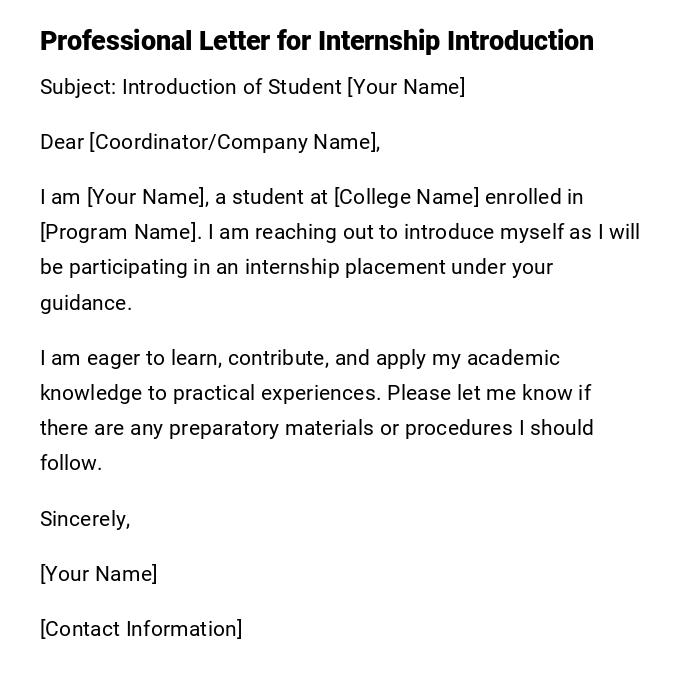
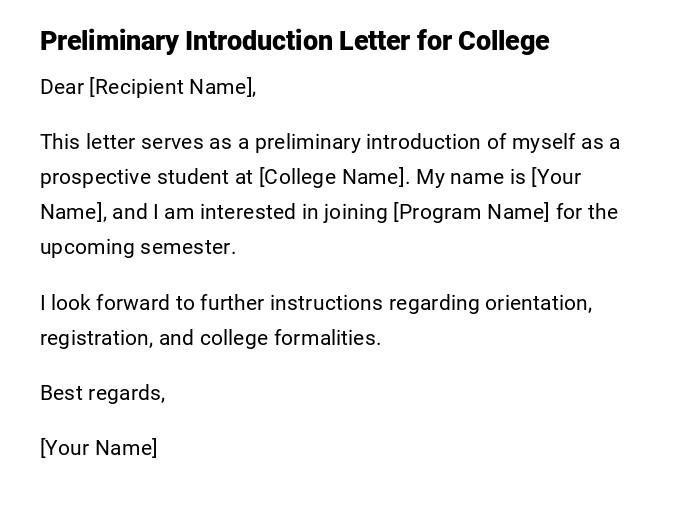
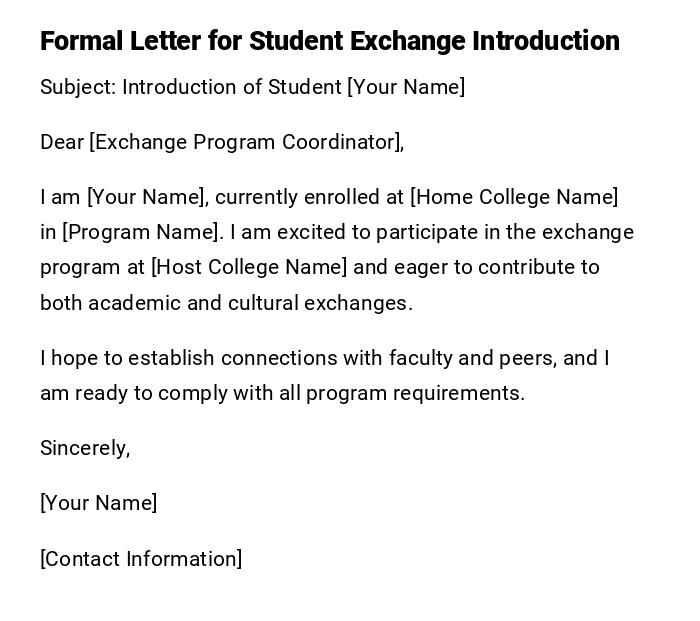








 Download Word Doc
Download Word Doc
 Download PDF
Download PDF